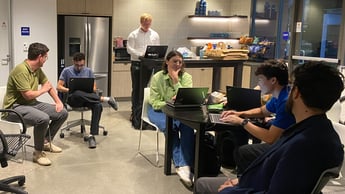Vulnerability management
Protect your business from major cyber threats with Vulnerability Management
As companies work hard to accelerate their digital transformation strategies, identifying and fixing software vulnerabilities is becoming an increasing challenge for CIOs and CISOs. While the acceleration of software development benefits digitalization, it also leads to more software, more versions, and consequently more potential vulnerabilities. New technologies such as AI create new attack surfaces. Additionally, AI is becoming a powerful tool for cybercriminals. Without proper vulnerability management, it is not a question of IF, but WHEN a significant vulnerability will be exploited and effectively used against your organization.

software development benefits digitalization, it also leads to more software, more versions, and consequently more potential vulnerabilities. New technologies such as AI create new attack surfaces. Additionally, AI is becoming a powerful tool for cybercriminals. Without proper vulnerability management, it is not a question of IF, but WHEN a significant vulnerability will be exploited and effectively used against your organization.
1. Introduction
Cybercrime is a global business. More than 2,200 cyberattacks occur each day. On average, data breach incidents cost companies more than $3.9 million. And malware attacks cost companies an average of $2.6 million.

According to the Federal Office for Information Security in Germany (BSI), last year saw over 2,000 vulnerabilities in software products on average per month (15% of which were critical). Exploiting vulnerabilities is a professional ‘industry.’ Software vulnerabilities are therefore of significant interest to organized crime and are considered a major risk to our economy—and to your business.
As a result, vulnerability management is no longer an option but a necessity for the long-term survival of your company. It's like regular crime: the easier it is, the higher the chance of becoming a victim. Therefore, it is crucial to make it as difficult as possible through measures in technology, processes, and people.
2. Vulnerability management
A vulnerability is a flaw in software, hardware, or configuration that can be exploited by an attacker to gain unauthorized access or to execute malicious code. These flaws can be caused by various factors, such as:
- Coding Errors: Developers may make mistakes in their code.
- Misconfigurations: System administrators may misconfigure software or hardware.
- Software Bugs: Software products may have inherent flaws that attackers can exploit.
- Third-Party Components: Security gaps can exist in third-party components, such as plugins.
Vulnerability management is a risk-based, systematic approach to identify, assess, and address vulnerabilities in your IT infrastructure. Implementing it as a continuous process provides two key benefits:
- You reduce Risk and Potential Impact from Cyber threats
By proactively identifying and assessing vulnerabilities, you can address them before they are exploited by malicious actors. This reduces the number of entry points available for hackers. While unknown vulnerabilities will not be addressed until they are discovered, having only a few vulnerabilities to respond to is preferable to managing many.
- You increase Cybersecurity Awareness within your organization
Your employees are also an attack vector: a method used by attackers to enter your organization. Not only IT staff but everyone is crucial in the fight against cybercrime. A single phishing email can cause numerous problems. By raising awareness, you ensure that your employees can better recognize risks and know whom to contact in the event of a security incident.
Prevention is better than cure. Therefore, vulnerability management is a vital weapon against the threats of cybercrime that no organization can afford to neglect. But where should you start? How do you implement this process?
2.1 Step-by-step implementation
Without insight into your security posture, you won't know where you need to strengthen your defenses. At this stage, it's too early to implement a continuous process. It is better to start small, by identifying your IT assets and vulnerabilities, and taking appropriate actions.
 2.1.1 Identify: IT Asset Management
2.1.1 Identify: IT Asset Management
IT asset management involves tracking and managing all IT assets, including devices such as computers, routers, and servers, as well as applications, cloud instances, and IoT devices. Effective vulnerability management relies on an up-to-date inventory of all assets connected to the network. This requires using both automated tools for detection and manual processes to ensure that no assets are overlooked. However, this does not mean you need to wait until you have a complete overview before starting to address vulnerabilities. As IT assets are discovered, vulnerabilities can be identified. Various detection technologies can be employed, including scanning, penetration testing, and manual inventory. This process will lead to an initial overview of vulnerabilities.

2.1.2 Assess and prioritize
Next, each vulnerability needs to be assessed in two areas: severity and potential impact. A global standard for this is the CVSS (Common Vulnerability Scoring System). A CVSS score of 9-10 is classified as "Critical."
 Critical vulnerabilities could cause significant damage if exploited, leading to reputational and financial losses. They require immediate action.
Critical vulnerabilities could cause significant damage if exploited, leading to reputational and financial losses. They require immediate action.
Unclassified vulnerabilities refer to those that have been identified but not yet assessed.
The CVSS score provides a prioritization for remediation but does not account for additional threat information. For this purpose, Qualys has developed the QDS: "Qualys Detection Score." In addition to the technical characteristics, QDS also considers how similar vulnerabilities have been exploited and whether remediation measures are in place.

By combining CVSS and QDS, you ensure that your resources are prioritized to the most critical vulnerabilities in your organization.
2.1.3 Remediate
The goal of remediation is to ensure that vulnerabilities cannot be exploited and that your security posture is improved. Full remediation of a vulnerability is the preferred solution, but sometimes that may not be possible yet. For example, if a software vendor has not yet provided a fix. In such cases, mitigating the vulnerability can still significantly reduce the risk, which will then be reflected in a lower CVSS/QDS score.
Remediation or mitigation measures include:
- Patching firmware and software (patches)
- Updating firmware and software (enhanced versions)
- Changing or improving security configurations
- Implementing workarounds (e.g., taking a server offline)
- Training your employees and, if applicable, business contacts for awareness
By following these three steps (Identify, Assess, Remediate), you will quickly achieve a higher level of security. You will reduce the number of attack vectors, vulnerabilities, and potential impacts, and your organization will be more aware of the current cybersecurity threat landscape.
Unfortunately, cybercrime is also evolving. With AI becoming a tool for hackers, and 70 new vulnerabilities emerging per day, a continuous process is required to stay as secure as possible. Moreover, implementing workarounds does not constitute a structural improvement in your security posture. Over time, these workarounds may be forgotten and become ineffective. Therefore, implementing a continuous process for vulnerability management is an essential next step.
2.1.4 Continuous process
Once the most significant risks have been addressed, it's time to implement vulnerability management as a continuous process. To achieve this, two additional steps are added to the three previously mentioned:
- Dashboards: to maintain an up-to-date overview of vulnerabilities, an automated dashboard should be set up. This eliminates the need for manual reporting, which is tedious and time-consuming. Tools like Qualys can assist in creating such dashboards, as shown below.

- Improvement: while addressing vulnerabilities, you may encounter recurring issues. This indicates a structural problem. For example, you might find that certain software has a high rate of new vulnerabilities per month. A structural improvement could involve increasing the frequency of regular patch cycles for this software so that you are not dependent on emergency patches. Alternatively, you might decide to switch to a different application with better software development quality and enhanced security.
This continuous approach significantly strenthens your security posture, as vulnerability management becomes a proactive process that focuses on both immediate remediation and long-term enhancements to your security. Moreover, as it is implemented as a day-to-day process, the security awareness of your employees improves every day.

To sustain this process, the steps must be automated as much as possible. Without automation, your employees will need to continue performing manual tasks that do not add value to your business and cannot be maintained at the same high quality.
3. Automation
3.1 The four primary beneftis
Automation takes vulnerability management to a higher level without additional costs, mainly for the following four reasons:

- Enhanced effectiveness
Continuous scanning and remediation allow vulnerabilities to be identified and addressed in real time. The faster you detect vulnerabilities, the sooner you can respond. This quickly reduces the risk of a successful attack. - Reduced manual work
Due to a persistent shortage of security specialists, it is necessary to focus on the most important tasks. Automation significantly reduces the manual effort required for vulnerability management, allowing your security experts to focus on the most critical tasks. - Improved efficiency
Automated systems can scan large networks and systems much faster than humans. They operate around the clock without additional costs. Moreover, automation requires the streamlining of processes and workflows – and with that reducing complexity. This standardization ensures faster response times and accelerated remediation. - Cost Savings
Automation requires an initial investment, but it quickly pays off as operational costs are significantly lower compared to manual work by security experts. Keeping people working around the clock is not only unhealthy but also very expensive.
3.2 Key components to automate
The key components to automate are identification, assessment and prioritization, remediation, and reporting & dashboarding. In other words, every single step can be automated.

By automating these processes, you can focus on the insights gained and on implementing relevant structural improvements. Given the large number of new vulnerabilities emerging daily, this is the only way to keep your security posture optimal.
How can Itility help you?
Inspired by this whitepaper? Let us assist you. We support large enterprises with IT challenges and have a results-oriented way of working.
Step by step, we support your projects and assist your employees. Leveraging the capabilities of Big Tech, we design and implement security solutions for your IT environment.






